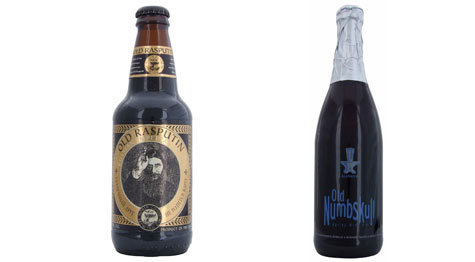
HEADED FOR THE CELLAR Alesmith Old Numbskull and North Coast Old Rasputin. |
Most people agree that fresh is better. The same is true in the world of craft beer. Except when it isn't.
Generally speaking, hops and malts are more flavorful, carbonation is spot-on, and beer just plain tastes better when fresh. Lighter beers in particular can begin to decline in quality after only three months, so consumers should always check the born-on date (and more brewers need to provide said date). Oxidation (where oxygen slowly seeps into the bottle), prolonged exposure to room temperature, or even direct sunlight can make your beer taste stale, flat, sour, or skunky.
That said, some beers don't need to be consumed right away, and could even be better if aged. Barley Wines, Old Ales, Imperial Stouts, Bocks, many Belgian styles, and other beers with high alcohol content can mellow and gain character when aged. Highly hopped beers can also be aged since hops are a natural preservative, but personally I don't want that delicious hop flavor to fade and prefer them fresh. More and more brewers are experimenting with specialty barrel aging (NEWPORT STORM just debuted their CYCLONE SERIES QUINN, a porter aged in rum barrels), but aging is something any beer lover can attempt.
The first step after identifying a beer that should age well is to buy two, drinking and taking notes on the first with which to compare later. Ideally the beer should be stored in cellar-like conditions — consistently cool without contact to direct sunlight. Obviously, waiting is the hardest part; to enjoy the benefits of aging, you'll have to exercise the willpower not to drink the beer for a year or more.
I caught my first glimpse at the potential of vintage beers last year at a STONE BREWING beer dinner at Julian's in Providence. They brought several big beers that aged well, but my favorite was the 2006 IMPERIAL RUSSIAN STOUT. By drinking this alongside the 2009 version, you could see how three years had made it mellower, with a balanced flavor, and very drinkable. Similarly, a highlight from last fall's Beervana Fest in Cranston was BROOKLYN BREWERY's delicate and flavorful 2006 LOCAL 1, a Belgian Strong Pale Ale.
Now a believer in the power of aging, I tracked down a bottle of 2001 GALE'S PRIZE OLD ALE at the British Beer Company restaurant in Walpole, Massachusetts. Sadly, time wasn't kind to the carbonation since it poured almost entirely flat, with an alcohol that was still chocking. I had much greater success with a dusty bottle of 2007 J.W. LEES HARVEST ALE that I found tucked away at my local package store. Four years of aging produced a wonderfully complex, creamy, and sweet Barleywine that demands to be sipped.
Of course, if you want to age beers right, do it yourself. My own ex-beeriment started three years ago when I purchased a pack of DOGFISH HEAD'S IMMORT ALE, an American Strong Ale. I drank the first two immediately, discovering a beer that is copper-ruby in color with a minor head and aroma dominated by raisins, hops, and alcohol. Notes of maple and vanilla join dark fruit and alcohol in the flavor. Mouthfeel was smooth and considerably livelier than I expected.